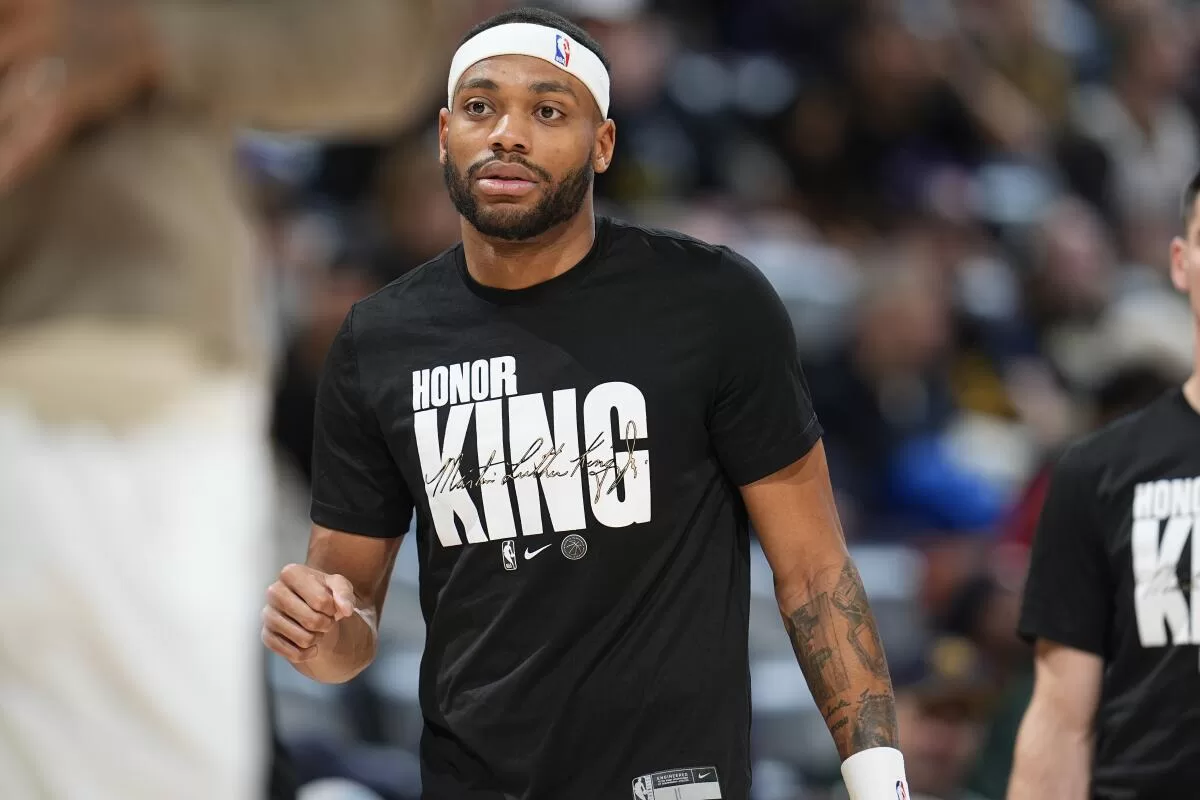The fog of the previous month had begun to clear, the frustrations with coaching decisions, inconsistent effort, travel and injuries giving way to more harmonious basketball.
They again looked refreshed early against the Brooklyn Nets on Friday night, the ball popping from one player to another as the Lakers built double-digit leads multiple times in the first half.
But it was “fool’s gold,” a phrase one Lakers player has used to describe the team’s high points throughout the season.
As the numbers this season tell you, the Lakers’ offense would eventually falter. The defense, as the numbers would tell you, wouldn’t be much more than OK. And over 24 minutes in the second half, that optimism from earlier in the week evaporated with another loss.
So what now?
The Lakers (21-22), currently 10th in the Western Conference standings, can start to rebuild again Sunday against the 14th-place Portland Trail Blazers, but the reality is that it doesn’t seem as if there’s a switch that can be flipped to figure all this out.
Maybe it’s too reactionary, but the loss to the Nets doesn’t feel like the outlier. It was much more of a predictable hiccup for a team that hasn’t been consistent for most of the first half of the season.
They’ve got a strong fastball — they threw it against the Thunder and the Mavericks — but consistency is a mess.
Change, it would seem, will be inevitable.
The diagnosis
This isn’t simple.
The Lakers have a bunch of issues, the biggest maybe being the lack of two-way players. It’s forced the coaching staff to try to balance lineups, and they’ve rarely found anything reliable.
Their transition defense and defensive rebounding, things that can be related to overall effort, have been huge issues. They give up too many three-pointers and they don’t take (and make) enough on their own.
Spiritually, they seem frayed at best — the frustrations from everything that’s come since the in-season tournament have been directed at a lot of different people including coach Darvin Ham. This month, praise for opposing coaches from LeBron James and D’Angelo Russell hasn’t gone unnoticed.
Gabe Vincent’s lost season has mattered, the Lakers not getting any punch from their biggest free-agency acquisition. Ham said he’s on pace in his recovery, but whatever he gives the Lakers after the All-Star break can’t be counted on.
Knowing that Ham has support in the front office and ownership, the fixes either have to be internal or via trade.
The options
Internally, there’s not a lot the Lakers can do.
They can continue to harp on more consistent play calling, relying less on freelance offense. They can continue to preach defensive energy and focus. And, as their backs are pushed further against the wall, maybe the team finds the same level of urgency that it had in the final months of last season.
Externally, expect the Lakers to be aggressive.
Atlanta guard Dejounte Murray seems like the primary trade target, with the Lakers having talked about a trade centered on Russell, rookie Jalen Hood-Schifino and their 2029 first-round pick. But Murray has been on an absolute tear for the Hawks over the past week, the asking price undoubtedly on the rise. Atlanta asked for Austin Reaves, predictably, but the Lakers have continued to show no interest in trading him.
Forward Bruce Brown, whom the Lakers aggressively pursued in free agency, is back in play after he ended up in Toronto as part of the Pascal Siakam trade. With a skill set that fits on any contender, the Lakers will have competition for Brown’s acquisition.
Veteran forward Bruce Brown is one of several players who could draw the Lakers’ interest on the trade market in the coming weeks.
(David Zalubowski / Associated Press)
There’s interest in Washington point guard Tyus Jones and center Daniel Gafford, Charlotte guard Terry Rozier and Brooklyn’s wings Royce O’Neal (whom they were discussing in draft night trades) and Dorian Finney-Smith.
And while the Lakers continue to register no real interest in a Zach LaVine deal, they would still covet Alex Caruso — the former Laker though the Bulls don’t seem to have real interest in trading him.
All of this can change in the push to the trade deadline — as well as the Lakers’ motivations to be aggressive.
The dilemma
As the team has stumbled over the last month, management has to wonder just how worth it a big deadline trade would be.
Two seasons ago during Russell Westbrook’s first year with the Lakers, they elected to hold because they viewed the cost to be greater than the amount of improvement they could attain.
The same questions will again be asked in the next few weeks as the team decides how much future equity it’ll pour into a team featuring James, a 39-year-old star with a contract option after the season, Anthony Davis and an almost annual date for the play-in round of the playoffs.
The future first-round pick, unprotected draft swaps, Max Christie and Hood-Schifino would be the best tools for the Lakers to acquire talent. But dealing a large combination of those assets for only marginal improvement might be a worst-case scenario.
“That first half is what we’re working toward,” Ham said after losing to the Nets. “Coming out of those last two games, those last two wins, and then the inconsistency showed up, reared its head in the second half. But we can’t feel sorry for ourselves and make excuses. We saw the same people that put together that first half were the same ones that allowed that second half.
“And we just have to decide which team we’re gonna be.”
Maybe they’ll get to make that choice. Or maybe a trade will make that decision for them.
